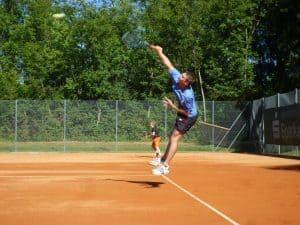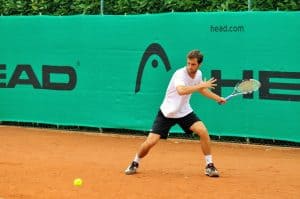These Are The Four Styles of Tennis
There are 4 main styles of tennis getting played on courts all around the world everyday. The styles are serve and volley, baseline, counterpunch, and all around. Each style has variations and spin offs that may or may not incorporate some of the other styles, but by and large almost every player can fit into these 4 styles. There are ways to identify them, and even better ways to beat them.

Serve and Volley
The serve and volley is only one strategy that is part of a bigger strategy of being a net player. The serve and volleyer will come to the net behind their serve, not waiting for a return from the opponent. The speed in which the player can get to the next position will help them control the point.
The point of the point for a serve and volley player is to make it as quick as possible. In an ideal world the serve allows for a simple return. From here the server has successfully positioned themselves for a precise volley. This volley is to be the winning shot or is placed well enough to allow for the next volley to be the winning shot.
The footwork and positioning of the player after the serve is crucial to the success of this type of player. They can either close and eliminate opportunities with great footwork or open them up with poor positioning.
How Do I beat the serve and volley?
Challenges of the Serve and Volley
When executed properly, it is nearly impossible to beat the serve and volley player. This is one of the more offensive styles of tennis. Pete Sampras made the greatest male tennis career all-time (before the recent push of Federer, Nadal, and Djokovic, of course) based on the serve and volley style. Of course it helped that he had a fierce forehand and more than adequate backhand to back it up. That wasn’t what won him 7 Wimbledons though.
No, his bread and butter was giving you a powerful, well placed serve and using his long strides to almost float instantly to the net to close of any angle you thought you had and place a perfect volley angled to the service line umpire for a winner or the perfect set up shot for his work of art overhead jump smash. It was a thing of beauty that not even the greatest return man of the time (and maybe all time) could beat him when they both played their best.
Overcome The Challenges
So, if Agassi couldn’t do it, then how can I? Well, you’re not going to play Pete Sampras, so you have that going for you. You will have to begin by minimizing their control of the point. A well placed return, particularly low and to the left or right baseline will even things out a bit. From there, you may be able to begin to dictate a point if all they could do is put it back in play.
When it comes to this style opponent, the more shots you hit the higher your chances for winning the point go. A serve and volley style depends on short points, and a players game may not be suited for the longer demands a rally might put on them.
Keep them on the baseline, so that you are accomplishing the goal of a longer point as well as taking their number one strength, their net game, away. Try to step into the court more for your returns in order to catch the serve on the rise. This will not give the server enough time to reach the net before the ball comes back at them, forcing them to make a shot before their ready and one they aren’t necessarily used to making.

Baseline
The baseline tennis player is exactly as stated: they live on the baseline. They aren’t unwilling to go to the net, but they know it is an area of weakness, not strength. Their ground strokes are usually refined to the point they are comfortable with both forehand and backhand dominated points.
They look for openings in the court to hit winners and are happiest when they can move their opponent from side to side to create these openings. They will pounce on short balls hit in no man’s land (about halfway between service and baseline or closer to service line), using the geometry of the court and position of the opponent to their advantage to create a winner.
How to beat a baseliner
Bringing a baseliner up to the net is a great way to neutralize their ground stroke game. If we can take away an opponents strength and use ours, that will give us a huge advantage. Moving them forward and backward will put them out of their comfort zone, and open up opportunities for you. Using deep shots to begin with and then sprinkling in some drop shots is a perfect mix.

Counterpunch
Similar to a baseliner, the counterpuncher lives and dies on or behind the baseline. The biggest difference between this and some of the other styles of tennis is the counterpuncher isn’t looking to exploit winners as much as not make mistakes. The idea is to hit as few errors as possible, and in turn making your opponent hit more errors by trying for more winners. This is only accomplished if you can limit the winners as well, of course, but that is the idea!
A counterpuncher rarely gets tired, and is adept at making sure the ball is put back to you in a spot that is difficult to make anything significant happen. They will out run you, out shoot you, and just plain wear you out. It can be exhausting and frustrating to play, but a few tips can change game in your favor.
How to beat a Counterpuncher
Attack the net to beat the counterpuncher. A counterpuncher is playing a game of patience, slowly working through points to force your hand. Well, force theirs. Moving up to the net will force them to make quick decisions, which they won’t feel comfortable with, forcing them to make the same mistakes they are attempting to make you make.
Also, moving them front to back is a great way to keep them off balance. Be careful not to try too much with the ball, as errors are just what they are looking for.

All Around
The all around player, the jack of all trades, the renaissance player is a tough cookie to crack. They can adapt to any style they need to fit the match, making them a tough out for anyone. Their weaknesses are usually masked well, but once they are found they should and could be exploited.
How to beat an all around player
The all around player is the most versatile of the tennis styles. To beat this style of player, use your best weapon. If you have a great forehand, get yourself in position to use it. If the volley is your game, use it. The downfall of an all around player is usually they don’t have a great shot they can go to in a pinch. Be aggressive and use this to your advantage.
Try to pigeon hole them into one style of playing, then beat that style. This may require you to become a bit of an all around player as well, but attempt to stay aggressive and force their hand.

Work What Works
Work the style that works best for you. From behind the baseline to at the net, passive to aggressive, there are lots of ways to win and lose a tennis match, just make sure above all else you are having fun along the way!
